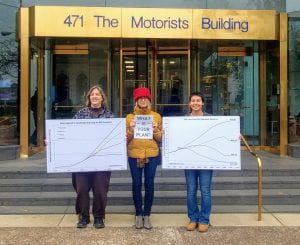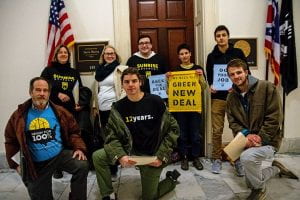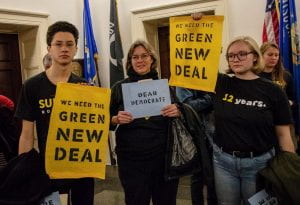During Spring 2019 I took the final required course for my Master’s in Public Administration at the John Glenn College of Public Affairs – PUBAFR 7900, the capstone research paper. In this course, students write a structured capstone paper on a project of their choice. Although the projects vary a lot, the papers all follow the same format:
-
- Title Page
- Executive Summary
- Table of Contents
- Introduction
- Background, including Stakeholders
- Literature Review
- Methods
- Data
- Results
- Conclusions
- Appendices
- Works Cited
As chair of the Sierra Club’s Ready for 100 Columbus campaign, I wrote my paper on how three cities that have committed to 100% renewable energy are getting there. At the time of my writing, 120 cities had made this commitment, including Cleveland and Cincinnati in Ohio, as well as several other major cities. I wanted to figure out a possible road map for Columbus.
Although I wrote about a topic I am extremely involved with — how cities can get to 100% renewable energy — the amount of rewriting and frankly unreasonable demands from the professor almost led me to withdraw from the course. No matter what I produced, it wasn’t right. If something was in a bulleted list, she wanted it in a table, but if it was in a table, she wanted a bulleted list. Even when I made the revisions asked for, it seemed she didn’t read them and said I hadn’t done the work. Halfway through the semester, she wanted me to change my topic!
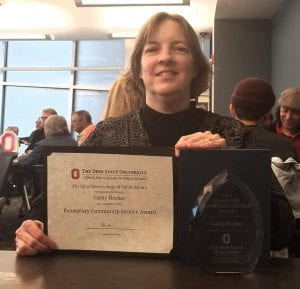
I got the Exemplary Community Service Award from the John Glenn College of Public Affairs at its pre-graduation ceremony in May.
But after encouragement from my Glenn College advisor, I stayed in, earning barely enough points to pass with a B, but I did get the B. And it’s a good thing because I not only learned a lot despite the difficulties, I also was able to graduate. Even better, during the Glenn College pre-graduation ceremony, I was given the Exemplary Community Service Award.
In writing the paper, the first thing I had to do was identify which cities I was going to look at. I got a list of all cities that had made the commitment, then identified which ones are in the top 100 cities in the United States by population. Those included San Diego, San Francisco, Denver, Washington D.C., Portland, Atlanta, Minneapolis, Cleveland, St. Louis, Saint Paul, Cincinnati, Orlando, and Madison, Wis. Of these, most had made the commitment within the past year, and only about half had published energy plans for how they would get there.
Of the cities with published energy plans, I picked three: San Francisco, the first city to make a commitment to 100% renewable energy in 2010; Atlanta, the only city to include a full consideration of policy alternatives in its climate plan; and Cincinnati, which has the most comprehensive plan of all large cities that have committed to this transition.
I also consulted the academic and think tank literature. On the academic side, I found that most people who study this question believe cities, states, and countries can transition to 100% renewable energy, but there’s a debate between those who think it can be done using only sun, wind, hydro, and geothermal, and those who believe it must include nuclear energy. The 100% renewable energy side is led by Mark Jacobson of Stanford University, founder of the Solutions Project who mapped out how states, cities, and countries can get to 100% renewable energy. The critics include 21 scientists who published an evaluation of Jacobson’s work in Proceedings of the National Academy of Sciences. The dispute was covered by David Roberts in Vox here and here.
I also found a lot of think tank and advocacy group literature on how cities can transition to 100% renewable energy. The two best sources were the Carbon-Free City Handbook, published by Rocky Mountain Institute, which looked programs cities could implement by sector such as buildings, transportation, and energy supply, and Pathways to 100, a primer for how cities can use legislative, financial, and structural practices to transform their energy supplies.
I found that by instituting best energy practices on the city level, rather than depending on state or federal action, cities could take control of their energy supplies and significantly lower their carbon emissions. San Francisco, which has been working on programs to get to 100% renewable energy since 2011, has significantly lowered its emissions.
I was also able to put together a high-level blueprint for how cities can get to 100% renewable energy:
STEP 1: ENERGY EFFICIENCY
Buildings are the top source of carbon emissions in most cities. Making energy efficiency upgrades helps by reducing the amount of energy being used, which both lowers emissions and saves money. Also called retrofitting and weatherization, energy efficiency includes activities such as installing LED lights and EnergyStar appliances, adding insulation, sealing windows, and using low-flow plumbing. This needs to be done on both the residential level, particularly in low-income areas where housing is often very inefficient, and in large commercial buildings, financed through the Property Assessed Clean Energy program. Cities can also require or incentive new builds to be LEED-certified or net zero, and they need to address the split incentive in which which tenants pay for energy, so landlords don’t want to pay for upgrades. This can be done by requiring landlords to list energy costs with rent or by providing incentives for landlords to make needed upgrades.
STEP 2: RENEWABLE ENERGY
To run on 100% renewable energy, we need more renewable energy! This includes building out solar generation on city property, and helping residents and businesses to install more solar. Cincinnati is building 25 MW of solar to run its water treatment plans, and Cleveland has a solar farm on a capped landfill. San Francisco has incentives for purchasing solar equipment as well as a solar equipment leasing program, which has lowered costs and spread solar panels on homes and businesses across the city. In Ohio, Solar United Neighbors runs bulk purchasing programs.
STEP 3: TRANSPORTATION
Transportation is the second large source of carbon emissions in cities. Cities have a lot of options for tackling transportation emissions, such as converting their own fleet to electric vehicles, encouraging residents to drive EVs, rolling out charging infrastructure, supporting biking, walking, and scooters, offering bike share and car share programs, and building bus rapid transit and light rail. City form is also important. Channeling development into the city center rather than urban sprawl lowers emissions from cars and makes getting around by public transportation, biking, or walking easier.
STEP 4: ENERGY SUPPLY
The most effective way to lower carbon emissions from energy use is to ensure that the energy supply is generated from renewables. This can be done in two ways: building more utility-scale solar and wind generation, and using renewable energy certificates to offset fossil fuel use. In Ohio, we have a third option: Aggregation. This is when a city pools together its customers and uses them to bargain with utilities for more renewable energy at a lower price. Cincinnati is aggregated for 100% renewable. Aggregation is legal in only eight states, and we are lucky Ohio is one.
STEP 5: FINANCING
Whenever renewable energy comes up, the first question is usually “But how will you pay for it?” Fortunately cities have lots of financing mechanisms to choose from, including programs like Property Assessed Clean Energy, bulk purchasing, power purchase agreements, green banking, and more. For example, Los Angeles allows low-income residents to “rent” their rooftops to the city electric utility, which installs solar panels that put clean energy on the grid. Atlanta offers a “round it up” program for people to pay a little extra on their utility bills; the money funds energy efficiency upgrades in low-income areas. New York has a Green Bank that works with private-sector banks to fund clean energy developments.
Here’s a link to my Glenn College capstone paper: Getting to 100: How Cities are Transitioning to 100% Renewable Energy (pdf)
Here’s a link to my capstone presentation: Getting to 100: How Cities are Transitioning to 100% Renewable Energy (ppt)

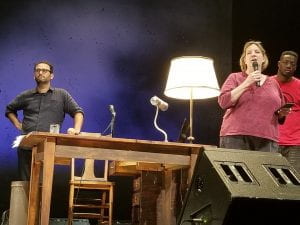




 Another Sierra Club success happened on December 4, when we packed a hearing by the Public Utilities Commission of Ohio on AEP’s proposal to build 400 MW of utility-scale solar generation in southeast Ohio. About 55 people turned out to testify, with every single person testifying in favor of the proposal. I testified on behalf of Ready for 100 explaining that cities want their electricity to come from renewable energy. My tweet about the hearing got 20 retweets and almost 7,300 views.
Another Sierra Club success happened on December 4, when we packed a hearing by the Public Utilities Commission of Ohio on AEP’s proposal to build 400 MW of utility-scale solar generation in southeast Ohio. About 55 people turned out to testify, with every single person testifying in favor of the proposal. I testified on behalf of Ready for 100 explaining that cities want their electricity to come from renewable energy. My tweet about the hearing got 20 retweets and almost 7,300 views.


